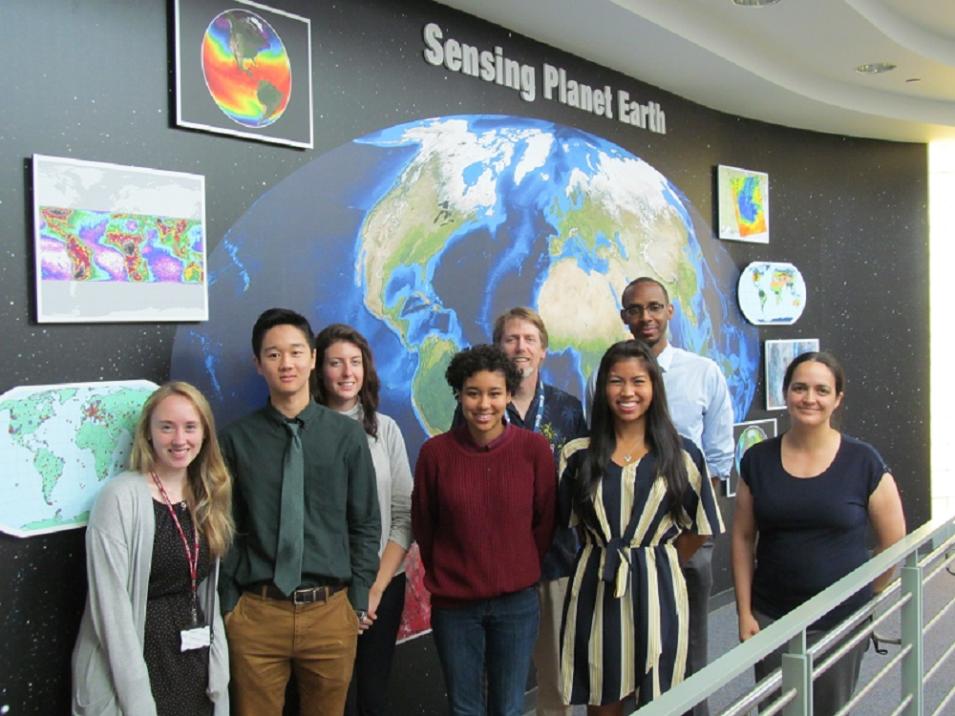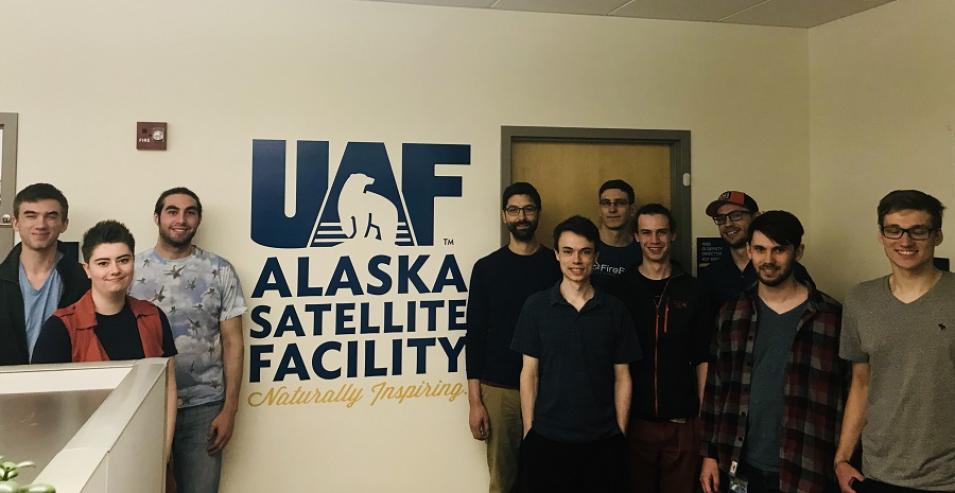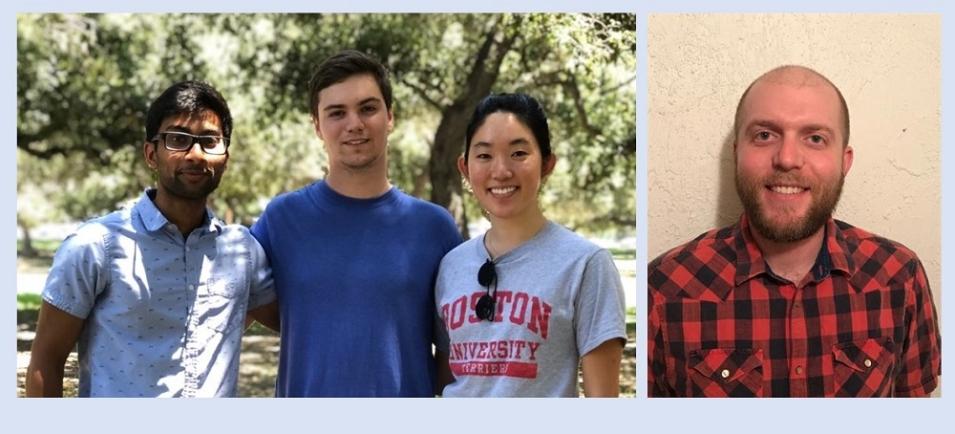| DAAC or Office |
Intern |
School Attending |
Academic Year |
Project |
| ASDC |
David (Preston) Callaway |
Virginia Tech, Blacksburg, VA |
Junior |
Assisting the Asset Manager in preparing legacy hardware for excessing. This involves removing hardware from cabinets, degaussing hardware (as appropriate), placing hardware in the excess area, and notifying the Asset Manager that hardware is ready to be tagged for excess. |
| ASDC |
Ronald Crump |
University of Virginia, Charlottesville, VA |
Junior |
Designing the front end and back end database for the Cassiopeia Airborne Data Search Tool as well as working with the integration of the front end of the tool. |
| ASDC |
Kathy LaMarsh |
D'Youville College, Buffalo, NY |
Entering fourth year of dietetics program |
Assisting with quality assurance/quality control (QA/QC) for extended maps and metadata tables for the Airborne Data Search Tool. This work helps develop the tool’s search functionality and provides support for the tool’s metadata schema. |
| ASDC |
Medha Majety |
Yale University, New Haven, CT |
Freshman |
Comparing and analyzing two products from Cloud-Aerosol Lidar and Infrared Pathfinder Satellite Observation (CALIPSO) satellite data that detect Polar Stratospheric Clouds (PSC) and creating visualizations for exploratory data analysis using 3D visualization software (such as Google Earth, CesiumJS, or NASA WorldWind). |
| ASF DAAC |
Rowan Biessel |
University of Alaska Fairbanks |
Junior |
Enhancing the functionality of ASF's Hybrid Pluggable Processing Pipeline (HyP3) custom processing engine by adding time series processing capabilities for Synthetic Aperture Radar (SAR) data. |
| ASF DAAC |
Tyler Chase |
University of Alaska Fairbanks |
Sophomore |
Enhancing ASF website capabilities to provide event-driven processing and monitoring using SAR data. |
| ASF DAAC |
Hal Dimarchi |
University of Alaska Fairbanks |
Senior |
Developing a desktop application providing similar functionality as ASF's HyP3 custom processing engine. |
| ASF DAAC |
Kim Fairbanks |
University of Alaska Fairbanks |
Senior |
Enhancing ASF website capabilities to provide event-driven processing and monitoring using SAR data. |
| ASF DAAC |
Soeren Harms |
Karlsruhe Institute of Technology, Karlsruhe, Germany |
Junior |
Developing a new S-band and X-band boresight transmission tower for ASF antenna calibration to allow for calibrating the pointing, gain, and polarization fidelity of ASF-used antennas at their X- and S-band frequencies. |
| ASF DAAC |
Jake Herrmann |
University of Alaska Fairbanks |
Junior |
Developing a pipeline for publishing Sentinel-1 Radiometrically Terrain Corrected (RTC) products into the EOSDIS Global Imagery Browse Services (GIBS). |
| ASF DAAC |
Alana Kilby |
University of Alaska Fairbanks |
Junior |
Developing templates and leading the content management effort to support the redesign of the ASF website to provide an enhanced user experience and functionality. |
| ASF DAAC |
Alex Lewandowski |
University of Alaska Fairbanks |
Senior |
Developing capabilities to enhance the user experience by building Jupyter Notebooks to perform time series analysis with SAR data using OpenSARLabs. |
| ASF DAAC |
George Meier |
University of Alaska Fairbanks |
Senior |
Prototyping the use of Artificial Intelligence (AI) through the development of neural networks to perform automatic surface-type classification from SAR imagery. |
| ASF DAAC |
James Rine |
University of Alaska Fairbanks |
Sophomore |
Designing the ASF Platform as a Service (PAAS) infrastructure to integrate a private cloud environment into ASF operations. |
| ASF DAAC |
McKade Sorensen |
University of Alaska Fairbanks |
Junior |
Prototyping the use of AI through the development of neural networks to perform automatic surface-type classification from SAR imagery. |
| ASF DAAC |
Rohan Weeden |
University of Alaska Fairbanks |
Master's Degree Candidate |
Prototyping the use of AI through the development of neural networks to perform automatic surface-type classification from SAR imagery. |
| ESDIS Project Office |
Catherine (Kate) Hobart |
Baylor University, Waco, TX |
Master's Degree Candidate |
Improving the Earthdata Search end-user experience, including evaluating data analysis tools for determining their applicability for specific data holdings. |
| ESDIS Project Office |
Alyssa Kaewwilai |
Gettysburg College, Gettysburg, PA |
Senior |
Improving the Earthdata Search end-user experience, including evaluating data analysis tools for determining their applicability for specific data holdings. |
| ESDIS Project Office |
Junho Kim-Lee |
Cornell University, Ithaca, NY |
Sophomore |
Working on the CloudSciCode project to demonstrate the viability of the cloud environment for Earth observation data analysis applications. |
| ESDIS Project Office |
Sara Lytle |
Columbia University, New York, NY |
Master's Degree Candidate |
Working on the CloudSciCode project to demonstrate the viability of the cloud environment for Earth observation data analysis applications. |
| ESDIS Project Office |
Summerlyn Turner |
DePaul University, Chicago, IL |
Recent Bachelor's Degree Graduate |
Working on the CloudSciCode project to demonstrate the viability of the cloud environment for Earth observation data analysis applications. |
| GES DISC |
Divya Gupta |
University of Maryland, College Park |
Junior |
Creating feature onboarding tours for the GES DISC website using Intro.js and working on user experience (UX) design and prototypes for visual data search using videos. |
| GES DISC |
Rachel Li |
University of California, Berkeley |
Sophomore |
Investigating procedures and standards needed to properly manage social media data, specifically Twitter data, so that these data are made compatible with existing NASA operational environments and determining if these procedures and standards would limit machine learning demands. |
| GES DISC |
Matteo Russo |
Princeton University, Princeton, NJ |
Senior |
Investigating and implementing machine learning techniques for improving the quality of “passive” tweets (i.e., those filtered out of the Twitter stream) relating to precipitation reports and investigating the potential of such tweet-derived precipitation information to augment existing weather station data and satellite observations. |
| GES DISC |
Tiffany Shreves |
University of North Carolina, Asheville |
Senior |
Developing tools and resources to make data analysis more interactive and intuitive, including creating a tool that helps users easily plot data from Earth science satellite missions on a graph or a map to create visualizations that can aid in research and science communication efforts. |
| GES DISC |
Laura Zheng |
University of Maryland, College Park |
Senior |
Investigating techniques and tools to visualize relationships between publications in Earth science and machine learning. The goal is to create a method or tool allowing for better decision-making when applying machine learning algorithms to Earth science applications. |
| LP DAAC |
Nathan Nelson |
South Dakota School of Mines, Rapid City, SD |
Sophomore |
Excessing hardware and media from the LP DAAC collection, including updating the U.S. Geological Survey (USGS) enterprise inventory product, determining the usability of retiring rack-mounted devices, and conducting research to meet NASA and USGS policies and requirements. He also is drafting an upgrade plan to revise the LP DAAC VMWare cluster architecture. |
| ORNL DAAC |
Hannah Dattilo |
Oglethorpe University, Atlanta, GA |
Senior |
Developing a data platform that harmonizes ground, airborne, and satellite permafrost measurements. This work will extend the capabilities of ORNL DAAC’s Soil Moisture Visualizer and will include data from NASA’s Arctic Boreal Vulnerability Experiment (ABoVE) and other sources. |
| PO.DAAC |
Austin Ebel |
Columbia University, New York, NY |
Senior |
Working on a cloud-native service for translating queries used by the hydrological community into those used by remote sensing data stores to enable Surface Water Ocean Topography (SWOT) mission science. This will extend the capabilities of search across PO.DAAC and other DAACs. After this project, he will be looking into machine learning opportunities within PO.DAAC on search relevancy, metrics, and other areas. |
| PO.DAAC |
Karthik Garimella |
Washington University, St. Louis, MO |
Master's Degree Candidate |
Analyzing data distribution metrics at PO.DAAC using the beats and Elastic search systems. These integrated metrics will then be used to discover underlying patterns in data usage using data mining and machine learning algorithms. The prototype will be used to analyze the application of the methodology for understanding data ingest errors. |
| PO.DAAC |
Andrew Joseph |
Oregon State University, Corvallis, OR |
Senior |
Developing a web-based tool to transfer legacy document-based user guides to HTTPS web-based guides. |
| PO.DAAC |
Jacqueline Kim |
Pasadena City College, Pasadena, CA |
Sophomore |
Assisting the PO.DAAC User Services team in editing and generating content that appears on the website and social media channels. Also contributing insight and recommendations to the PO.DAAC User Services team on website and social media improvements to optimize user engagement. |
| SEDAC |
Dorothee Grant |
Columbia College, Columbia University, New York, NY
|
Sophomore |
Improving and integrating nighttime lights data from multiple sources into several SEDAC data collections. |



